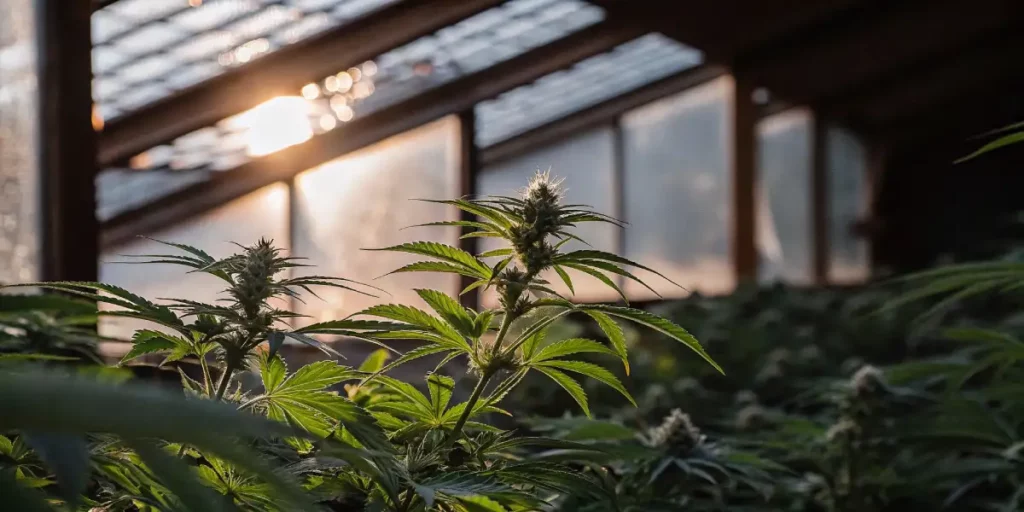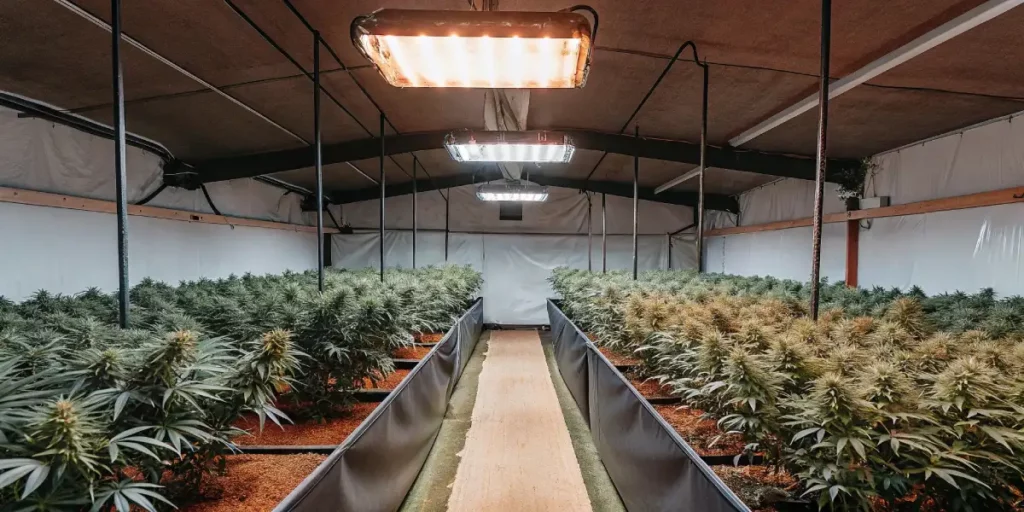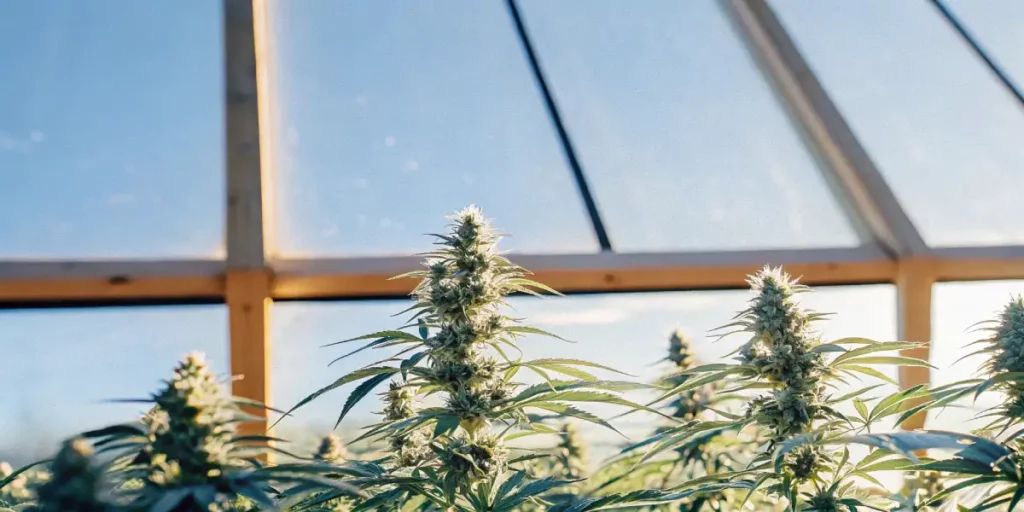When cultivating autoflowers, the concept of Daily Light Integral (DLI) is crucial. DLI measures the amount of light a plant receives in a day. For autoflowers, finding the optimal DLI can significantly impact growth and yield. Whether you’re starting with your first pack of seeds or are a seasoned grower, knowing DLI for autoflowers is essential.
Factors such as light intensity and duration play into DLI. As autoflowers don’t rely on light cycles to flower, maintaining the right DLI can boost their growth. A higher DLI means more light, which generally leads to better growth. However, it’s all about balance.
For instance, the effects of DLI on autoflower yield can be profound. Too little light, and your plants may not reach their potential. Too much, and you could cause stress. Let’s dig into how to find that sweet spot for your autoflowers.
Optimal DLI for Autoflower Cannabis
Finding the optimal DLI for autoflower cannabis involves knowing your specific setup. Indoor growers often have more control over lighting conditions. This allows you to tweak and experiment until you find what works best for your strains.
Many growers aim for a DLI of around 20-30 mol/m²/day for their autoflowers. This range provides ample light for photosynthesis without overwhelming the plants. Strains like the Super Skunk from Global Green Genetics thrive well in this DLI range.
It’s important to note that the optimal DLI for autoflower cannabis can vary depending on environmental factors such as temperature and humidity. When these conditions are perfect, the plants can efficiently utilize the light they’re given, maximizing growth potential. By keeping a close eye on these variables, you can ensure your autoflowers are receiving the ideal light conditions.
Knowing the nuances of DLI for autoflowers gives you the upper hand in cultivation. It allows you to adapt to changing conditions and address the needs of your plants. By fine-tuning the light environment, you can push your autoflowers to their fullest potential, ensuring lush growth and bountiful yields.
Calculating DLI for Autoflower Growth
Calculating DLI involves the light source’s intensity and the duration it’s on each day. Tools like PAR meters can help measure the light intensity. Multiply this by the number of hours the light is on to get your DLI.
For example, if your light provides 500 µmol/m²/s and is on for 18 hours, your calculation would be: 500 x 18 x 60 x 60 / 1,000,000 = 32.4 mol/m²/day. This provides a solid foundation for your autoflowers to grow.
The process of calculating DLI for autoflower growth may seem daunting, but it’s a vital step for any grower. By knowing the exact light requirements of your plants, you can tailor the growing environment to meet their needs. This attention to detail ensures that your plants receive consistent, optimal light conditions.
Moreover, using online tools and calculators can simplify the calculation process, making it accessible even for novice growers. These tools allow you to input your specific light conditions and quickly determine the DLI, providing a quick reference to guide your adjustments.

Adjusting DLI for Indoor Autoflowers
Indoor growing offers flexibility. You can control the light, temperature, and humidity. Adjusting DLI for indoor autoflowers is part of this control, allowing you to create ideal conditions for your plants.
Start with a baseline DLI, then adjust based on plant response. If leaves are wilting or showing signs of stress, you might need to lower the DLI. Conversely, if growth is sluggish, try increasing it.
Adjusting DLI for indoor autoflowers isn’t just about increasing or decreasing light. It’s about knowing the unique requirements of each strain you cultivate. What works for one strain might not work for another, so it’s crucial to monitor your plants closely and make informed adjustments.
Lighting technology continues to advance, providing growers with more precise control over their growing environments. By investing in adjustable lighting systems, you can easily manipulate the DLI to match the specific needs of your autoflowers, enhancing growth and maximizing yield potential.
DLI Recommendations for Autoflower Strains
Every strain has different needs. For instance, the Blue Dream autoflower may thrive with a slightly higher DLI, around 25-35 mol/m²/day. Meanwhile, a more delicate strain might require less.
It’s all about observing your plants. Healthy leaves, vigorous growth, and good flower production are signs that your DLI is on point. Regularly monitor your plants and adjust as necessary.
When considering DLI recommendations for autoflower strains, it’s important to remember that genetics play a significant role in light requirements. Some strains are naturally light-hungry, while others may thrive with less. Knowing these genetic differences can help you tailor your approach, ensuring each plant receives the care it needs.
Communities of growers often share their experiences and insights regarding DLI for autoflowers. Engaging with these communities can provide valuable information and recommendations specific to the strains you’re cultivating. By leveraging collective knowledge, you can optimize your grow setup and achieve impressive results.
Effects of DLI on Autoflower Yield
The right DLI can make all the difference in yield. Autoflowers exposed to optimal light conditions tend to produce more robust flowers. This means denser buds and higher potency.
However, too high a DLI can lead to light stress, reducing yield. Keep an eye on leaf color and texture. If they start to curl or discolor, it may be time to dial down the light intensity or duration.
The effects of DLI on autoflower yield are profound, with the potential to transform an average harvest into an exceptional one. By maintaining the correct DLI, you ensure your plants have the energy needed for vigorous growth and flower development, resulting in a bountiful yield.
Experimentation with different DLI levels can reveal the optimal conditions for your specific setup. By carefully documenting changes and outcomes, you can refine your approach, ultimately leading to consistently high yields and exceptional plant health throughout your growing cycles.
Practical Examples and Real-Life Adjustments
Consider the Gorilla Glue 4 autoflower. Many growers report impressive yields when maintaining a DLI around 28 mol/m²/day. This strain can handle more light, which translates to bigger buds.
If you’re growing multiple strains, remember each may have different DLI needs. Use this as an opportunity to fine-tune your setup. Record your findings and adapt your methods for future grows.
Practical examples and real-life adjustments provide a roadmap for knowing and implementing DLI for autoflowers. For instance, if a particular strain thrives under a higher DLI, you can use this knowledge to adjust your setup and replicate success across other grows.
Documenting your growing experiences and sharing them with others can create a wealth of knowledge, benefiting the broader cultivation community. By learning from real-life scenarios, you can make informed decisions that enhance your growing practices and lead to more successful harvests.

FAQs
What is DLI for autoflowers?
DLI, or Daily Light Integral, measures the total amount of light a plant receives in a day. For autoflowers, maintaining the right DLI is crucial for optimal growth and yield. It involves balancing light intensity and duration to meet the plant’s needs.
Autoflowers can thrive with a DLI range of 20-30 mol/m²/day. This ensures they get enough light for photosynthesis without causing stress. Adjusting DLI is part of creating ideal growing conditions, especially indoors where you have more control.
Knowing what DLI is for autoflowers helps demystify the science behind plant growth, making it accessible for all growers. With the right knowledge, you can transform your growing space into a thriving environment where autoflowers can reach their full potential.
By maintaining the optimal DLI for autoflower cannabis, you’re setting the stage for success. With careful monitoring and adjustments, you can address any issues that arise, ensuring your plants remain healthy and productive throughout their lifecycle.
How do I calculate DLI for autoflowers?
Calculating DLI involves the light’s intensity and how long it’s on each day. Use a PAR meter to measure intensity in µmol/m²/s. Multiply this by the hours of light per day to find the DLI. Online calculators can simplify this process.
For example, if your light provides 400 µmol/m²/s for 16 hours, your DLI is around 23 mol/m²/day. This calculation helps you tailor the light environment to your plants’ needs, enhancing growth and yield.
By accurately calculating DLI for autoflowers, you lay the groundwork for effective light management. This proactive approach ensures that your plants receive the precise amount of light required for optimal photosynthesis and development.
Furthermore, knowing DLI calculations empowers you to make informed decisions about your lighting setup. Whether you’re adjusting light schedules or exploring new lighting technologies, this knowledge is a critical component of successful cultivation.
What are the signs of incorrect DLI in autoflowers?
Signs of incorrect DLI include leaf discoloration, curling, and stunted growth. If plants receive too much light, they may show stress signs like wilting or burnt edges. If too little, growth may slow down and leaves become pale.
Regularly monitor your plants and adjust the DLI as needed. Healthy leaves and vigorous growth indicate the DLI is well-suited to your autoflowers. This observation is key to successful cultivation.
Recognizing the signs of incorrect DLI in autoflowers is crucial for maintaining plant health. By being vigilant and responsive to these indicators, you can swiftly make adjustments that prevent long-term damage and ensure continued growth.
Proactive monitoring and timely interventions are essential components of effective DLI management. By knowing the signals your plants send, you can create a stable environment where autoflowers can flourish, leading to successful harvests.
How does DLI affect autoflower yield?
The optimal DLI can significantly impact autoflower yield. Proper light conditions promote robust flower development, leading to denser buds and more potency. On the flip side, incorrect DLI can reduce yield due to stress or insufficient growth.
Monitoring and adjusting your DLI helps maximize yield. By providing the right amount of light, you create an environment where your plants can thrive. This balance is crucial for achieving the best results.
Knowing how DLI affects autoflower yield allows growers to maximize their crop potential. By maintaining the optimal light conditions, you support healthy growth and maximize the production of quality buds, resulting in a rewarding harvest.
Keeping meticulous records of your DLI adjustments and their effects on yield can help refine your growing practices over time. This data-driven approach ensures that you consistently achieve impressive results, optimizing both the yield and quality of your autoflowers.
Can I adjust DLI for different autoflower strains?
Yes, adjusting DLI for different strains is often necessary. Each strain may have unique light requirements. For instance, some strains may thrive with a higher DLI, while others prefer less.
Experiment with different DLI levels and observe plant responses. Use these insights to refine your setup for each strain. This customization leads to healthier plants and better yields, enhancing your overall growing experience.
Tailoring DLI for different autoflower strains is essential for achieving optimal growth. By knowing the specific light needs of each strain, you can create a customized environment that maximizes their growth potential and yield.
Experimentation and observation are key components of this process. By documenting your findings and continuously refining your approach, you can develop a deep knowing of how to best support each strain’s unique requirements, leading to successful and rewarding cultivation.

